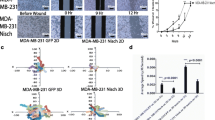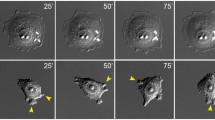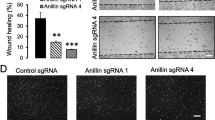Abstract
Basic fibroblast growth factor (FGF-2) expression takes place during morphogenic differentiation of mammary ducts and is lost in breast cancer. Forced re-expression of FGF-2 in breast cancer cell lines induces a more differentiated phenotype and inhibits motility by unknown mechanisms. Here we demonstrate that MDA-MB-231 cells with encumbered motility due to forced re-expression of FGF-2 have activated focal complexes as determined by immunoprecipitation/western blotting and immunofluorescence staining with antibodies to FAK, p130Cas, paxillin, vinculin and phosphotyrosine. The activation of the focal adhesion complexes results in loss of stress fibers associated with malignant transformation of mammary epithelial cells and the formation of circumferentially-distributed actin bundles associated with non-transformed mammary epithelial cells. These effects require continuous FGF-2 expression, as the effects of exogenous recombinant FGF-2 are only small and transient. FGF-2 expression results in an increase in integrin α3 expression and decreases in integrin β1 and β4 expression. These changes, however, induce only a small decrease in adhesion to uncoated and fibronectin-coated tissue culture dishes suggesting that the primary cause of impaired motility is due to intrinsic signaling. These data suggest that FGF-2-inhibits motility in breast cancer cells by stabilization of focal complexes and induction of a more differentiated phenotype with disruption of stress fiber formation and a characteristic cortical actin distribution.
Similar content being viewed by others
References
Sinowatz F, Schams D, Plath A, Kolle S: Expression and localization of growth factors during mammary gland development. In: Mol JA, Clegy RA (eds) Biology of the Mammary Gland. Kluwer Academic Press, New York, 2000, pp 19–25
Gomm JJ, Smith J, Ryall GK, Baille R, Turnbull L, Coombes RC: Localization of basic broblast growth factor and transforming growth factor-beta 1 in the human mammary gland. Cancer Res 51: 4685–4692, 1991
Luqmani YA, Graham M, Coombes RC: Expression of basic broblast growth factor, FGFR1 and FGFR2 in normal and malignant human breast, and comparison with other normal tissue. British J Cancer 66: 273–280, 1992
Anandappa SY, Winstanley JHR, Leinster S, Green B, Rudland PS, Barraclough R: Comparative expression of broblast growth factor mRNAs in benign and malignant breast disease. Br J Cancer 69: 772–776, 1994
Korah R, Sysounthone V, Golowa Y, Wieder R: Basic broblast factor confers a less malignant phenotype in MDA-MB-231 human breast cancer cells. Cancer Res 60: 733–740, 2000
Korah R, Sysounthone V, Scheff E, Wieder R: Intracellular FGF-2 promotes differentiation in T-47D breast cancer cells. Biochem Biophys Res Comm 277: 255–260, 2000
Gumbiner BM: Cell adhesion: the molecular basis of tissue architecture and morphogenesis. Cell 84: 345–357, 1996
Klein S, Bikfalvi A, Birkenmeier TM, Giancotti FP, Rifkin DB: Integrin regulation by endogenous expression of 18–kDa broblast growth factor-2. J Biol Chem 271: 22583–22590, 1996
Klein S, Giancotti FG, Presta M, Albelda SM, Buck CA, Rifkin DB: Basic broblast growth factor modulates integrin expression in microvascular endothelial cells. Mol Biol Cell 4: 973–982, 1993
Cance W, Liu E: Protein kinases in human breast cancer. Breast Cancer Res Treat 35: 105–114, 1995
Owens L, Xu L, Vraven R, Dent G, Weiner T, Kornberg L, Liu E, Cance W: Overexpression of the focal adhesion kinase (p25FAK) in Invasive human tumors. Cancer Res 55: 2752–2755, 1995
Zhong C, Kinch MS, Burridge K: Rho-stimulated contractility contributes to the broblastic phenotype of Rastransformed epithelial cells. Mol Biol Cell 8: 2329–2344, 1997
Mauro L, Sisci D, Bartucci M, Salerno M, Kim J, Tam T, Guvakova MA, Ando S, Surmacz E: SHC-a5b1 integrin interactions regulate breast cancer cell adhesion and motility. Exp Cell Res 252: 439–448, 1999
Peterson OW, Ronnov-Jessen L, Weaver VM, Bissell MJ: Differentiation and cancer in the mammary gland: shedding light on the old dichotomy. Adv Cancer Res 98: 135–161, 1998
Schwartz MA: Integrins, oncogenes, and anchorage independence. J Cell Biol 139: 575–758, 1997
Nakamura K, Iwamoto R, Mekada E: Membrane-anchored heparin-binding EGF-like growth factor (HB_EGF) and diphtheria toxin receptor-associated protein (DRAP27) /CD9 form a complex with integrin a3b1 at cell–cell contact sites. J Cell Biol 129: 1691–1705, 1995
Gui GP, Wells CA, Yeomans P, Jordan SE, Vinson GP, Carpenter R: Integrin expression in breast cytology: a novel predictor of axillary metastasis. Eur J Surg Oncol 22: 254–258, 1996
Cary LA, Han DC, Polte TR, Hanks SK, Guan J-L: Identification of p130Cas as a mediator of focal adhesion kinase-promoted cell migration. J Cell Biol 140: 211–221, 1998
Klemke RL, Leng J, Molander R, Brooks PC, Vuori K, Cheresh DA: CAS/Crk coupling serves as a molecular switch for induction of migration. J Cell Biol 140: 961–972, 1998
Varnum-Finney B, Reichardt LF: Vinculin-deficient PC12 cell lines extend unstable lamellipodia and lopodia and have a reduced rate of neurite outgrowth. J Cell Biol 127: 1071–1084, 1994
Crowley E, Horwitz AF: Tyrosine phosphorylation and cytoskeletal tension regulate the release of broblast adhesions. J Cell Biol 131: 525–537, 1995
Rabinovitz I, Mercurio A: The integrin beta6alpha4 functions in carcinoma cell migration on laminin-1 by mediating the formation and stabilization of actin-containing motility structures. J Cell Biol 139: 1873–1884, 1997
Rousseau S, Houle F, Kotanides H, Witte L, Waltenberger J, Landry J, Huot J: Vascular endothelial growth factor (VEGF)-driven actin-based motility is mediated by VEG-FR2 and requires concerted activation of stress-activated protein kinase 2 (SAPK2/p38) and geldanamycin-sensitive phosphorylation of focal adhesion kinase. J Biol Chem 275: 10661–10672, 2000
Wells A, Ware MF, Allen FD, Lauffenburger DA: Shaping up for shipping out: PLCgamma signaling of morphology changes in EGF-stimulated broblast migration. Cell Motil Cytoskeleton 44: 227–233, 1999
Aplin AE, Howe A, Alahari SK, Juliano RL: Signal transduction and signal modulation by cell adhesion receptors. Pharmacol Rev 50: 197–258, 1998
Jones JL, Royall JE, Critchley, DR, Walker RA. Modulation of myoepithelial-associated alpha6beta4 integrin in a breast cancer cell line alters invasive potential. Exp Cell Res 235: 325–333, 1997
van der Pluijm G, Vloedgraven H, Papapoulos S, Lowick C, Grzesik W, Kerr J, Robey PG. Attachment characteristics and involvement of integrins in adhesion of breast cancer cell lines to extracellular bone matrix components. Lab Invest 77: 665–675, 1997
DiMilla PA, Stone JA, Quinn JA, Albeda SM, Lauffenburger DA: Maximal migration of human smooth muscle cells on bronectin and type IV collagen occurs at an intermediate attachment strength. J Cell Biol 122: 729–737, 1993
Leventhal PS, Shelden EA, Kim B, Feldman EL: Tyrosine phosphorylation of paxillin and focal adhesion kinase during insulin-like growth factor-I-stimulated lamellipodial advance. J Biol Chem 272: 5214–5208, 1997
Wang F, Nohara K, Olivera A, Thompson EW, Spiegel S: Involvement of focal adhesion kinase in inhibition of motility of human breast cancer cells by sphingosine 1–phosphate. Exp Cell Res 247: 17–28, 1999
Lin VC, Eng AS, Hen NE, Ng EH and Chowdhury SH: Effect of progesterone on the invasive properties and tumor growth of progesterone receptor-transfected breast cancer cells MDA-MB-231. Clin Cancer Res 7: 2880–2876, 2001
Nakamura K, Yano H, Uchida H, Hashimoto S, Schaefer E and Sabe H: Tyrosine phosphorylation of paxillin alpha is involved in temporospatial regulation of paxillin-containing focal adhesion formation and F-actin organization in motile cells. J Biol Chem 275: 27155–27164, 2000
Somasiri A, Howarth A, Goswami D, Dedhar S, Roskelley CD: Overexpression of the integrin-linked kinase mesenchymally transforms mammary epithelial cells. J Cell Sci 114: 1125–1136, 2001
Price JT, Tiganis T, Agarwal A, Djakiew D, Thompson EW: Epidermal growth factor promotes MDA-MB-231 breast cancer cell migration through a phosphatidylinositol 3'-kinase and phospholipase C-dependent mechanism. Cancer Res 59: 5475–5478, 1999
Author information
Authors and Affiliations
Rights and permissions
About this article
Cite this article
Korah, R., Choi, L., Barrios, J. et al. Expression of FGF-2 alters focal adhesion dynamics in migration-restricted. Breast Cancer Res Treat 88, 17–28 (2004). https://doi.org/10.1007/s10459-004-6006-2
Issue Date:
DOI: https://doi.org/10.1007/s10459-004-6006-2




